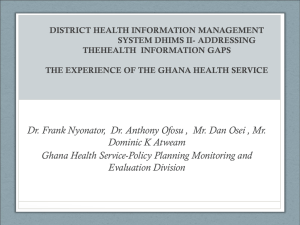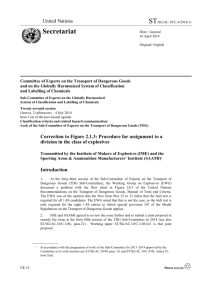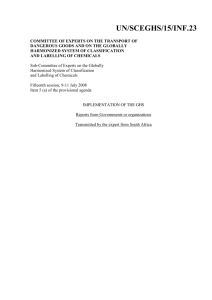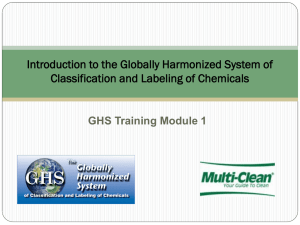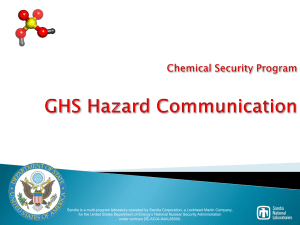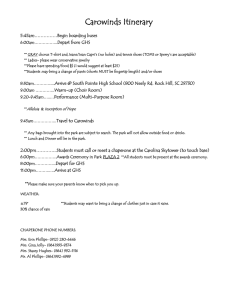Doc - unece
advertisement
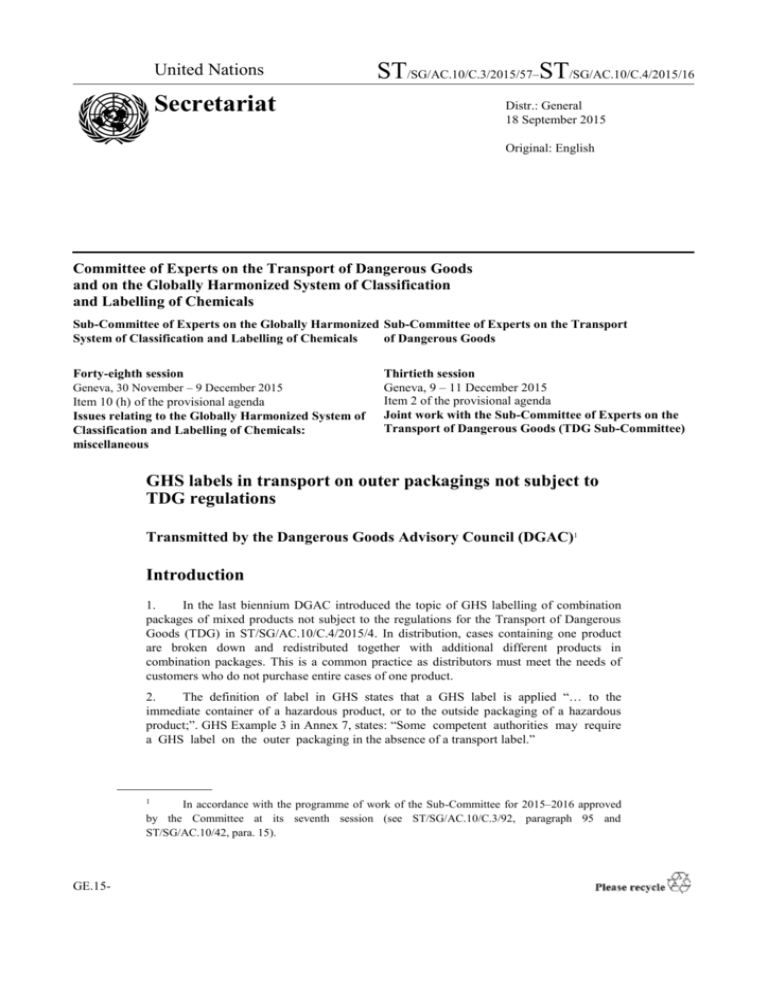
United Nations ST/SG/AC.10/C.3/2015/57–ST/SG/AC.10/C.4/2015/16 Secretariat Distr.: General 18 September 2015 Original: English Committee of Experts on the Transport of Dangerous Goods and on the Globally Harmonized System of Classification and Labelling of Chemicals Sub-Committee of Experts on the Globally Harmonized Sub-Committee of Experts on the Transport System of Classification and Labelling of Chemicals of Dangerous Goods Forty-eighth session Geneva, 30 November – 9 December 2015 Item 10 (h) of the provisional agenda Issues relating to the Globally Harmonized System of Classification and Labelling of Chemicals: miscellaneous Thirtieth session Geneva, 9 – 11 December 2015 Item 2 of the provisional agenda Joint work with the Sub-Committee of Experts on the Transport of Dangerous Goods (TDG Sub-Committee) GHS labels in transport on outer packagings not subject to TDG regulations Transmitted by the Dangerous Goods Advisory Council (DGAC)1 Introduction 1. In the last biennium DGAC introduced the topic of GHS labelling of combination packages of mixed products not subject to the regulations for the Transport of Dangerous Goods (TDG) in ST/SG/AC.10/C.4/2015/4. In distribution, cases containing one product are broken down and redistributed together with additional different products in combination packages. This is a common practice as distributors must meet the needs of customers who do not purchase entire cases of one product. 2. The definition of label in GHS states that a GHS label is applied “… to the immediate container of a hazardous product, or to the outside packaging of a hazardous product;”. GHS Example 3 in Annex 7, states: “Some competent authorities may require a GHS label on the outer packaging in the absence of a transport label.” 1 In accordance with the programme of work of the Sub-Committee for 2015–2016 approved by the Committee at its seventh session (see ST/SG/AC.10/C.3/92, paragraph 95 and ST/SG/AC.10/42, para. 15). GE.15- ST/SG/AC.10/C.3/2015/57 ST/SG/AC.10/C.4/2015/16 3. From a regulatory perspective, the mingling of different immediate containers containing products, hazardous under the GHS, in a transport package can result in an infinite combination of hazards determined not by the manufacturer but by the customers’ order. It is neither practical nor feasible to anticipate all possible combinations of potential GHS labels in distribution operations, and the presence of multiple labels on the outer package of a non-dangerous goods shipment creates problems of comprehension. 4. Co-mingled containers are not a problem for GHS implementations where only the immediate container must be labelled. However, in some GHS implementations there is a concept of “labelling up through the layers”, i.e. that every layer should be labelled to always provide protection to workers in case of leaking packages. 5. The GHS Sub-Committee invited DGAC to return and continue the work. It was recognized that this issue could be difficult to resolve but has merit and a non-dangerous goods combination package without GHS labelling on it represents low hazard. DGAC considers GHS labelling on the outer packaging to have a large impact and it may reduce rather than enhance safety. Discussion 6. Upon further investigation, DGAC has found that GHS labelling beyond the immediate containment2 is having additional significant impacts on international commerce. We have expanded the scope of this proposal to cover the GHS labelling of non-dangerous goods beyond the immediate container, e.g. outer packagings of combination packagings and overpacks, also known as “transport packagings”.3 The GHS labelling of transport packages which are also immediate containers, such as drums and portable tanks, is not impacted by this proposal. 7. The GHS does not give specific instructions for the application of GHS labels other than for the immediate container, and leaves it to the competent authority to decide whether labelling of transport packages is required. We are aware of two approaches in implementation, (a) only label the immediate container, or (b) label all layers but do not label the outer packaging of a dangerous goods combination package, only the inner and any intermediate layers. This second approach is the focus of this proposal. 8. "TDG package hazard communication typically consists of UN number(s) and proper shipping name(s) marks (e.g. “UN 1993, Flammable liquids, n.o.s.”), and labels which consist of a pictogram (e.g. flame), with or without the hazard class text (e.g. “flammable liquid”), and the class or division number (e.g. “3”)."The text is generally 12mm in height or greater, in English, or for instance in Europe if not in English, then in 2 DGAC notes that packaging terms are not defined in Chapter 1.2 of the GHS. The following terms are defined in Chapter 1.2 of the TDG regulations: package, packaging, inner packaging, intermediate packaging, outer packaging, combination packaging, and overpack. When these terms are used in this proposal, they are used with the TDG meanings. We also use the term “immediate containment” in the GHS sense as a necessary concept. The term “transport packaging” is used informally amongst professionals, but does not appear in the GHS. We define it to be the minimum layer with which a product may be appropriately transported alone, e.g. the outer package of a combination package, and any additional layers, e.g. overpacks. 3 2 ST/SG/AC.10/C.3/2015/57 ST/SG/AC.10/C.4/2015/16 only two languages and not potentially all European languages as for GHS.4 A broad variety of goods may share a UN number and proper shipping name. These marks and labels are applied to dangerous goods in packing groups I, II and III, i.e. high, medium and low danger goods. For smaller package sizes of certain medium and low danger goods, a “limited quantity” exception may be used, which eliminates all the marks and labels just described, which are replaced with one limited quantity pictogram mark. 9. GHS labels often contain extensive fine print text which is more narrowly assigned than a UN number. Unlike TDG markings and labels, in addition to pictograms GHS labels contain complex and extensive text, which includes a signal word, hazard statement, potentially unlimited precautionary statements, distributor name, address & phone contact information and quantity of each product inside shipping carton. Also unlike TDG, in multi-lingual regions this is all multiplied by translation into multiple languages. 10. When a product with a TDG classification falls below the low danger threshold, it falls out of the TDG regulations but remains subject to GHS. For implementations requiring GHS labelling of transport packages, the effect to move from the limited quantity pictogram to a full GHS label. Thus there is an inconsistency because the degree of labelling is much higher for a product of lower hazard. 11. DGAC highlights three examples where GHS labelling of non-dangerous goods is causing significant difficulties. Practicality for Mixed Products 12. Significant difficulty arises in scenarios for samples and where pick-pack operations or distributors re-pack different product inner packages together in an outer packaging. These combinations are based on customer orders, and the number of possible shipping combinations is infinite and unplanned. In pick-pack operations, orders are typically filled on high speed, high volume automated lines within a manner of minutes from start to finish. Orders are often palletized and shipped on the same day the order is received. Also, upon customer receipt, the transport outer packaging is often immediately opened and discarded. 13. This results in significant challenges. Computerization of real-time labelling for these complex possibilities is not feasible. Manual reproduction of labels would be difficult. Depending on the number of different products, replication of individual labels on the outer packaging may not be possible, due to the quantity of unique labels that would have to be applied versus the available area of blank box exterior. 14. The shipment of samples for business-to-business purposes is another scenario. In such cases the number of different products involved may exceed one hundred. 15. The assumption in regulations requiring labelling of the transport package is that only one substance or mixture is contained in the combination package. However in cases where the rules on the transport of dangerous goods do not apply and where more than one substance or mixture with different hazard classifications are packed together, this approach is no longer helpful. Replication of the whole set of individual labels on the outer packaging may not provide coherent hazard information and safety advice, and can reduce safety by discouraging the affected parties from reading the large number of labels. 4 Various references in ADR, the European Agreement Concerning the International Carriage of Dangerous Goods by Road. 3 ST/SG/AC.10/C.3/2015/57 ST/SG/AC.10/C.4/2015/16 16. While GHS implementations which require labelling of the transport package typically except dangerous goods, DGAC members have encountered interpretations for mixed packages that both the LQ mark for the dangerous good and the GHS labels for the non-dangerous goods must appear, i.e. the exception only applies to the specific dangerous good and not the entire mixed package. 17. The quantity of labels required will often exceed the amount of space on the transport packaging. To fit all required labelling, a larger shipping carton would be required with added dunnage, which is environmentally wasteful and more costly. Conflicts in Air Transport 18. GHS is having impacts in air transport. The air mode is possibly the most restrictive of all transport modes due to the hostile environment at high altitudes (i.e. cold temperature, pressure differential) and the inability to evacuate an aircraft in flight in an emergency. Accordingly, air safety regulations are some of the most prescriptive and highly enforced safety regulations. The applicable air regulations are that of the International Civil Aviation Organization (ICAO), Technical Instructions for the Safe Transport of Dangerous Goods by Air (the TI). Additional measures are self-prescribed by the air carriers through the International Air Transport Association (IATA) Dangerous Goods Regulations (DGR). 19. Shipment acceptance procedures are highly developed in the air regulations and in air carrier company policies. A particular focus within these procedures is the identification of undeclared dangerous goods. Because of the risk, even small amounts at low hazard are stringently enforced. Although non-dangerous goods with GHS pictograms have no special controls in air transport, air carriers are now stopping and verifying shipments which are not declared as dangerous goods when GHS pictograms appear. GHS symbols which are duplicative of TDG symbols are noted as the most likely to indicate an improperly declared shipment; however the exclamation point and health hazard pictograms are still a factor. 20. The issue described is not a matter of training, but is a result of the enforcement policies of civil aviation authorities. Authorities use the concept of “constructive knowledge” that a person acts “knowingly” when “a reasonable person acting in the circumstances and exercising reasonable care” would have “actual knowledge of the facts giving rise to the violation.” Air carriers are specifically directed that ‘‘Information concerning the contents of suspicious packages must be pursued to determine whether hazardous materials have been improperly offered. A carrier’s employee who accepts packages for transport must be trained to recognize a ‘suspicious package’...” 5 21. The practice that an operator’s staff be adequately trained to assist them to identify and detect undeclared dangerous goods has been an industry standard in the IATA DGR for over 20 years. The IATA DGR information is intended to prevent undeclared dangerous goods in cargo from being loaded on an aircraft and prevent passengers from taking on board those dangerous goods that they are not permitted to have in their baggage.6 22. The air transport carriers began noticing GHS pictograms on transport packages, and in 2013 they moved to address how to handle this in the context of constructive knowledge, i.e. what to do when a package is “suspicious” because it has GHS pictograms on it. To address concerns around the presence of GHS pictograms on packages, IATA submitted a proposal to the 24th meeting of the ICAO Dangerous Goods Panel, working paper DGP/24WP/72. 4 5 US Federal Register, Doc. 05–19659, Vol. 70, No. 194 / Friday, October 7, 2005 6 id at page 58803. ST/SG/AC.10/C.3/2015/57 ST/SG/AC.10/C.4/2015/16 23. As a result of the IATA proposal, the ICAO DGP inserted a new note in their acceptance procedures in Part 7 – Operator’s (Carrier’s) Responsibilities, Chapter 1;1.1.2, as follows: “Note 1 – Diamond-shaped GHS pictograms on packages may indicate the presence of dangerous goods. While some pictograms identify substances that only pose a hazard for supply and use, other GHS pictograms contain symbols that are largely equivalent to the symbols contained in the hazard labels used in transport, and which may therefore be classified as dangerous goods. For more information, see http://www.unece.org/trans/danger/publi/ghs/ghs_welcome_e.html.” 24. Recognizing that checks of these packages would impede shipments, they did not require a check, and stated the opinion of the panel that “Some were also concerned that a recommendation in the proposed text for acceptance staff to seek confirmation from the shipper would cause undue delays in shipment.” 7 25. IATA also made their own implementation in their Dangerous Goods Regulations, with many references added to GHS. They noted that the air waybill should state “Not Restricted, and the following was added as a note under Section 2.2 Hidden Dangerous Goods of the DGR 56th Edition: “Note: Diamond-shaped GHS pictograms on packages may indicate the presence of dangerous goods. While some pictograms identify substances that only pose a hazard for supply and use, other GHS pictograms contain symbols that are largely equivalent to the symbols contained in the hazard labels used in transport, and which may therefore be classified as dangerous goods. For more information, see Table B.4.A and http://www.unece.org/trans/danger/publi/ghs/ghs_welcome_e.html.” 26. As a result of enforcement of the “constructive knowledge” concept, air carriers have the responsibility to verify shipments where a GHS symbol appears on the transport package. This is avoided when the GHS pictograms only appear on immediate containers. 27. DGAC members have experienced similar situations in ocean freight where shipments are delayed when a UN number is not present on a package with a GHS label. Conflicts for Marine Pollutants 28. Threshold exceptions for environmentally hazardous substances were adopted in the UN Model Regulations 18th Edition via a special provision. Other than basic requirements to have good quality packaging and to be compatible with their packaging and other goods packed with them, they are no longer subject to TDG requirements below 5 L or 5 kg per inner or single package: “375 These substances when transported in single or combination packagings containing a net quantity per single or inner packaging of 5 l or less for liquids or having a net mass per single or inner packaging of 5 kg or less for solids, are not subject to any other provisions of these Regulations provided the packagings meet the general provisions of 4.1.1.1, 4.1.1.2 and 4.1.1.4 to 4.1.1.8.” 29. The International Maritime Organization adopted a corresponding measure with essentially identical text by creation of a new Section 2.10.2.7 in the International Maritime Dangerous Goods Code (IMDG), edition 37-14 (the 37th edition, issued in 2014, the current version of the code). This means that products which are classified as dangerous goods 7 Report of the 24th meeting of the Dangerous Goods Panel, 28 October to 8 November, 2013 5 ST/SG/AC.10/C.3/2015/57 ST/SG/AC.10/C.4/2015/16 solely on the basis of being a marine pollutant are exempted from dangerous goods regulations for ocean freight when in immediate containers of 5 kg or 5 L or less. 30. Similar text with results for air freight was adopted by ICAO in special provision A197 in the 2015-1016 edition of the TI. 31. Some practical impacts of this decision follow: • Avoids potential non-compliance issues which stop shipments; • Dangerous Goods declaration not required, resulting in air freight expense reduction of ~ $500,000 per DGAC member involved in these shipments; • No special driver qualifications for road transport from port to inland location. • No UN specification packaging testing, certification and recordkeeping; • Eliminates affixing multiple hazard labels and marks on small packagings by trained personnel; 32. Per the foregoing, Table A1.29a of the GHS is no longer correct. Environmentally hazardous substances in immediate containers of 5 L or 5 kg or less do not require the dead fish/dead tree mark in the UN Model Regulations. 33. Implementations of GHS which require environmentally hazardous substance labelling of transport packages when not consigned as dangerous goods are causing consternation to the shipping and freight forwarding communities when trying to use the TDG exceptions. They effectively invalidate the exception. 34. Similar situations will occur whenever TDG makes an exception and GHS requirements take effect, undoing the TDG exception. Summary 35. One goal of the GHS system was for supply and use regulations to be globally harmonized, similar in this regard to the existing TDG regulations. While competent authorities retain autonomy, minor concerns should make way for uniformity for the overall betterment of safety achieved by having one system which facilitates understanding, training and compliance. 36. The use of GHS labels on outer packagings should be considered in the context of what is required for higher tier hazards governed by the TDG regulations. When a dangerous good is present, GHS labelling does not apply to the outer packaging of a combination package. When TDG labelling is absent on goods falling below the TDG threshold the extent of hazard communication skyrockets. 37. Whenever the TDG system exempts a product from hazard communication, the GHS system is now requiring a label on the transport package. The impact may be such that it is better to be more highly regulated, which is inefficient. Future complications can be foreseen for labelling of transport packages wherever TDG and GHS labelling vary. These are summarized in GHS Annex 1 “Classification and labelling summary tables”. 38. In light of the impacts, what is the justification for requiring GHS labelling on transport packages for lower hazard goods not subject to the TDG Model Regulations? 6 ST/SG/AC.10/C.3/2015/57 ST/SG/AC.10/C.4/2015/16 Proposal 39. In GHS Chapter 1.2, delete the part of the definition of GHS label that includes outer packages: 40. Label means an appropriate group of written, printed or graphic information elements concerning a hazardous product, selected as relevant to the target sector(s), that is affixed to, printed on, or attached to the immediate container of a hazardous product, or to the outside packaging of a hazardous product; 41. In GHS Annex 7, Example 3, delete the asterisk for outer packaging and the note as follows: “Example 3: Combination packaging for a Category 2 skin irritant and Category 2A eye irritant Outer Packaging: Box with no label required for transport* Inner Packaging: Plastic bottle with GHS hazard warning label … * Some competent authorities may require a GHS label on the outer packaging in the absence of a transport label.” 7
